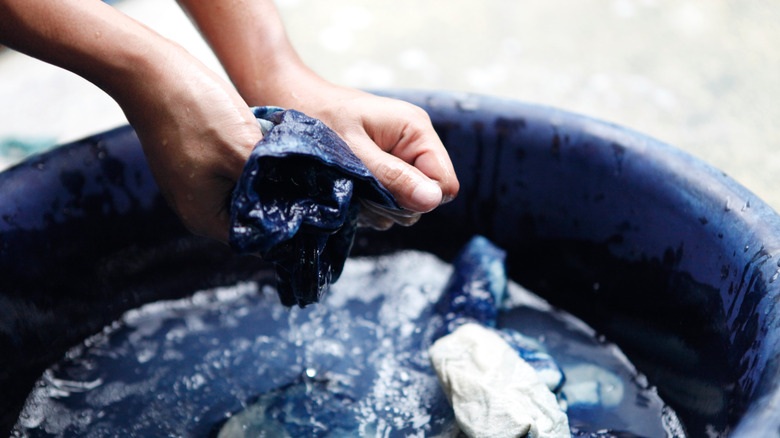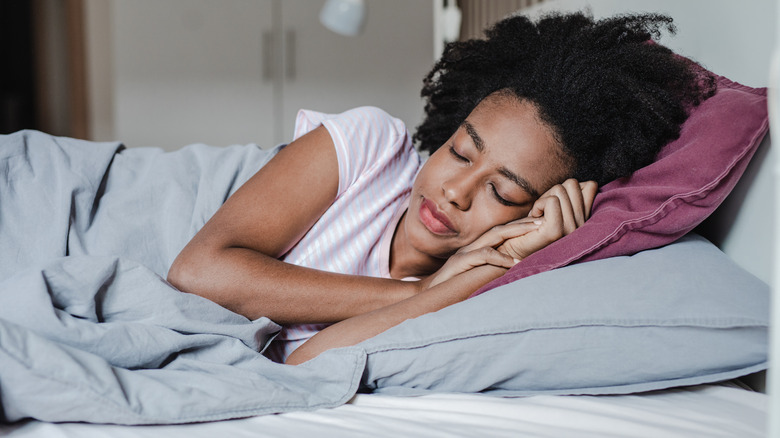Could The Color Of Your Pajamas Be Affecting Your Sleep?
The importance of sleep is being talked about quite a lot now. Despite the influence of hustle culture and multi-tasking, and late nights being touted as the road to success, TikTok and other social media platforms are also romanticizing night-time routines and sleep hygiene, and for good reason. Per experts, healthy adults should be aiming for anywhere between seven to nine hours of undisturbed sleep every night.
Say you've put your phone away, switched off the TV, meditated, and dimmed the lights. Now you're under the covers, and you're drifting off to sleep. Before you know it, your skin feels irritated, and you're itching all night. Turns out that the color of what you choose to wear to bed could be affecting your sleep too.
Are the pajamas you put on dark-hued? Those could be the culprit, according to licensed, board-certified pediatrician Dr. Patricia Pinto-Garcia (via Best Life). "[Dyes] are more likely to cause contact dermatitis — any itchy, red rash that is usually worse where fabrics cling against like the armpits, groin, back of knees, and arm creases," shared the doctor. This might be a concern, especially for those who have sensitive skin. Who knew you needed to add pigments to your list of things you didn't realize were ruining your sleep?
Textile dye allergy can be extremely uncomfortable
You may notice signs of the allergic reaction, also called textile dye allergy, immediately or days after you put on your new pair of pajamas, per WebMD. Symptoms often include itchy and red skin in the areas where the clothes came into contact with your skin.
Once the suspect has been identified (in this case, the pajamas) and removed, your allergy symptoms should go away without any medication, but there are some times when the rash could persist, in which case you should be seeing a healthcare provider about it (via WebMD).
"One of the top triggers is blue. These blue clothing dyes are used to make different colors of clothing, such as black, blue, purple, and other dark colors. Other colors may also be a trigger, especially certain orange or red dyes," explained dermatologist Dr. Rajani Katta, who adds that blue is a hue that is used to make other colors as well. So, how can you know if the color of your night clothes is going to ruin your sleep?
Preventing pajama color-induced contact dermatitis
One way to know for sure if your pajamas are affecting your sleep (unfortunately) is to wear them and see if the dye is irritating your skin. Another way is to avoid dark hues and stick with lighter shades, as they usually contain smaller amounts of dye (via Best Life).
But if you really like darker shades, you can try running your clothes through a wash cycle or two to see if that helps. As Dr. Susan Nedorost, a professor of dermatology at Case Western Reserve University, told TIME, "By washing new clothing, you might remove a little extra dye and so have a lower exposure." If you've already worn a dark-hued pair of night clothes and you're suffering the consequences of textile dye-induced contact dermatitis, swear off the pajamas for eight weeks and see if your skin improves, shared Dr. Rajani Katta.
Indeed, figuring out what colors and what brands of clothes work might involve a bit of detective work. Not all clothes are made equal, though; higher-quality fabrics might not be as problematic. So there is hope yet for those out there who cringe at lighter shades and instantly reach for darker hues on clothes racks. Just watch for reactions, try to zero in on the culprit, and find out what works for your skin so that you can get a restful night's sleep in your favorite pair of pajamas.



